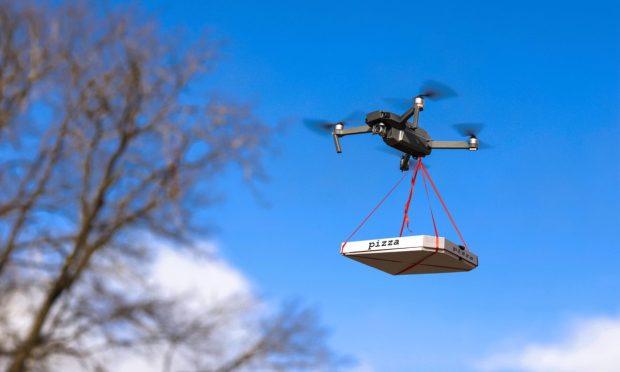
As restaurants look for more efficient and cost-effective ways to meet consumers’ desire for on-demand delivery, Papa John’s is tapping drones to keep the food hot until it gets to customers’ doors.
The restaurant’s drone delivery provider Flytrex shared in an emailed press release Thursday (Sept. 14) the launch of Autonomous Pickup, with the machines picking up orders from the restaurant with a dropdown wire and handing them off to consumers, cutting out the middleman who would otherwise get the food to the machine. The process takes roughly five minutes from when the food is ready.
In an interview with PYMNTS, Papa John’s Vice President of Digital Engineering and Services Yasaswi Pulavarti said as the restaurant tries out different delivery methods, an advantage of drone delivery with Autonomous Pickup is the speed it offers — an important factor, given how hot pizza needs to be kept for the consumer to enjoy it.
“There’s no one clear answer in terms of multimodal delivery,” Pulavarti said. “As we see many options that are evolving in the industry, we want to constantly learn, and one of the things [this technology] would solve is the speed to delivery, … the to-their-door time. … That is the key problem to solve, which in turn will solve the customer satisfaction scores. The food needs to look good and hot.”
Pulavarti noted that the temperature must be kept at 140 degrees at a minimum for “the most optimal taste.” As such, when the delivery is faster, the food has less time to cool.
There remains significant demand for restaurant delivery. PYMNTS Intelligence from surveys of thousands of consumers for the “Connected Dining” series revealed that, while delivery aggregators accounted for only 5% of restaurant orders as of June, 41% of respondents reported having used them in the last six months. Additional research from the series noted that delivery overall accounts for about 10% of restaurant orders.
Consumers’ early experiences with the technology have been positive, according to Pulavarti. There has been “greater frequency” than expected and once consumers have tried it, they start “ordering more and more.”
Additionally, the technology has benefits such as enabling consumers to order to public spaces like parks — ones that are “not strictly residential” — without the hurdles of getting a person to those places.
Looking ahead over the next few years, Pulavarti said he expects restaurant delivery to grow more efficient, with different delivery modes suited to different areas — autonomous vehicles, human-driven vehicles, drones or sidewalk rovers, depending on what kind of environment the delivery is taking place in.
Plus, he said he expects that new fulfillment models could emerge, such as ones where delivery orders are brought to “a certain junction or co-located space” and picked up from there by drones to optimize the process.
“I think restaurant delivery will definitely be multimodal in three years,” Pulavarti said. “… I can see different models evolving, and we are thinking in that way: How do we fit in that picture as this evolves?”